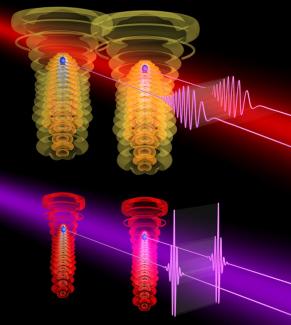Imagine laser-like x-ray beams that can “see” through materials––all the way into the heart of atoms. Or, envision an exquisitely controlled four-dimensional x-ray microscope that can capture electron motions or watch chemical reactions as they happen. Such exquisite imaging may soon be possible with laser-like x-rays produced on a laboratory optical table. These possibilities have opened up because of new research from the Kapteyn/Murnane group.
For example, one important part of a microscope is the light used to illuminate the sample. Exciting recent experiments by Assistant Research Professor Tenio Popmintchev, the K/M group, and colleagues from around the world used an ultraviolet (UV) laser and converted its light to much shorter wavelengths via high-harmonic generation (HHG). The researchers successfully generated a comb of bright extreme UV and soft x-ray harmonics that are ideal for imaging the nanoworld. This discovery complements the rainbows of harmonics that can be produced using mid-infrared lasers that this team demonstrated in 2012. This stunning accomplishment, until recently thought to be impossible, was reported online in Science on December 4, 2015.
The JILA researchers contributing to this breakthrough include Tenio Popmintchev, graduate students Dimitar Popmintchev and Christopher Mancuso, former research associates Carlos Hernández-García, Franklin Dollar, and Ming-Chang Chen, former student assistant Amelia Hankla, Fellows Agnieszka Jaron-Becker, Andreas Becker, Margaret Murnane, and Henry Kapteyn. The JILA team collaborated with colleagues from the University of Salamanca (Spain), National Tsing Hua University (Taiwan), Cornell University, Temple University, and Lawrence Livermore National Laboratory.
For Tenio Popmintchev and the Kapteyn/Murnane group, the success of their new HHG experiment was a Back to the Future moment. The process of high harmonic generation in gases was discovered using UV lasers nearly 28 years ago. But, because scientists at that time didn’t fully understand how to make this process efficient, attention turned to using longer-wavelength lasers for HHG. In fact, for many years, most scientists believed that producing soft x-ray harmonics with UV lasers would be impossible. As it turned out, it was not impossible. Instead, it was the ultraviolet surprise.
“In the very first experiments, they had driving UV lasers with much longer pulse durations,” Tenio Popmintchev explained. “Now, as the laser technology has advanced, we can make very high-energy driving lasers with pulse durations that are an order of magnitude shorter. This is what it takes to produce x-ray harmonics in this regime.” Knowing this, Tenio Popmintchev was able to build the right UV laser for the job.
Once the new laser was operational, the researchers discovered that it extended the reach of HHG well beyond what they expected. And, the process occurred in a very different way than with a mid-IR driving laser. The conversion of mid-IR laser light into x-ray light requires gently ionized atoms to add the radiation from all atoms constructively. In contrast, the conversion of UV laser light takes place in a cloud of multiply charged ions in a high-density plasma. Until this experiment, the researchers thought that a plasma would destroy the HHG efficiency by causing the HHG waves to interfere destructively.
Fortunately, in this new regime, the researchers were able to maximize the HHG emission from each ion and efficiently combine the HHG waves from many ions. In the HHG process, the laser rips an electron from an ion, then accelerates it away before driving the electron back to the same ion from which it originated. The brightness of the x-rays emitted depends on how likely it is that the electron recombines with the ion. For a UV laser, the electron spends less time away from the ion, so the x-rays that are created are brighter.
“If you use mid-infrared (IR) lasers, then you get a coherent supercontinuum rainbow of x-ray light,” said Margaret Murnane. “The very nice thing with UV lasers is that you get very narrow peaks. So this is yet another example of a powerful and beautiful ability to manipulate x-ray light using laser light.”
With mid-IR lasers, for example, the supercontinuum is like white light in the x-ray region. The supercontiuum is expected work well for watching chemical reactions, where a lot is going on. In contrast, a UV laser driving HHG produces a comb-like band of nano-linewidth harmonics. These harmonics are ideal for imaging tiny objects such as atoms, molecules, and nano-materials.
The Kapteyn/Murnane group is currently using its UV laser-generated harmonics to investigate nano-materials. Soon, the researchers hope to produce even shorter-wavelength light that will allow them to resolve biological materials such as DNA, RNA, proteins, and viruses.––Julie Phillips




